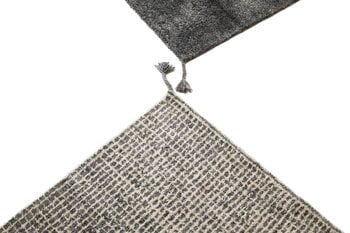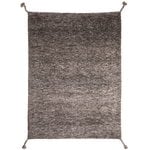The Uni rugs by Woodnotes are handmade from natural materials, making them the perfect choice for someone wishing to add a sense of warmth to their bedroom or living room. The name Uni is a reference to the rugs being unicolour and unique. The rugs have been hand knotted using natural materials, and therefore the shades are naturally varied. The rugs are made of 90 % wool and 10 % cotton, and they have not been treated chemically. Hence, the colours also vary slightly from rug to rug, as they do from sheep to sheep. As a fun little detail, braided wool fringes have been added to each corner of the rugs. The soft Uni rugs are available in several different colours and sizes.
Uni rug, grey
Woodnotes
Description
The Uni rugs by Woodnotes are handmade from natural materials, making them the perfect choice for someone wishing to add a sense of warmth to their bedroom or living room. The name Uni is a reference to the rugs being unicolour and unique. The rugs have been hand knotted using natural materials, and therefore the shades are naturally varied. The rugs are made of 90 % wool and 10 % cotton, and they have not been treated chemically. Hence, the colours also vary slightly from rug to rug, as they do from sheep to sheep. As a fun little detail, braided wool fringes have been added to each corner of the rugs. The soft Uni rugs are available in several different colours and sizes.
Product details (9)
- Material
- 90% wool, 10% cotton
- Colour
- Grey
- Length
- 0 in (0 cm)
- Width
- 0 in (0 cm)
- Height
- 0.79 in (20 mm)
- Yarn height
- 0.59 in (15 mm)
- Measurement details
- Weight: 8.16 lbs (3,7 kg) / m2
- Care instructions
- Vacuum regularly, do not use a beater bar or a rotating brush. Do not beat. Professional cleaning recommended. The carpet can also be cleaned with snow.
- Notes
- A new wool rug may temporarily produce fluff.
- Product ID
Reviews (0)
Sustainability
The Product Sustainability Framework, our criteria of sustainable design, helps you find the most sustainable products in our selection. Read below which sustainability criteria this product has met.
Working conditions & labour 8/9
-
Equal opportunities for all employees
-
Commitment to UN Global Compact, fair compensation for all employees
-
Corporate responsibility requirements defined and communicated for suppliers
-
Systematic work for improved inclusion and well-being in the workplace
-
Transparent supply chain
-
Suppliers' compliance to a code of conduct ensured
-
Compliance to the UN Guiding Principles on Business and Human Rights ensured in the supply chain
-
Support for community involvement in the supply chain
Eco-friendly production 9/9
-
Fair and resource-wise water-use in production
-
No incineration or landfilling of returned items
-
No use of endangered species as materials
-
No direct environmental emissions or waste (excl. GHGs) from production
-
The sustainability of direct suppliers' production is addressed and monitored
-
Production and material sourcing that respect biodiversity, animal rights, and natural ecosystems
-
Material-efficient and ecological packaging
-
Positive impact on nature’s well-being through operations that regenerate natural ecosystems
-
No potentially harmful chemicals used in own production
Climate impact 7/8
-
Company's direct greenhouse gas emissions identified and commitment to reduction
-
Product's carbon impact identified and commitment to reduction
-
Guidance on energy- and eco-efficient use of the product
-
Contribution to climate initiatives beyond the brand’s direct operations
-
Low-carbon or compensated transportation
-
Carbon footprint of the product calculated and goals set to reduce it
-
100 % renewable energy in own production and operations
Sustainable materials 6/6
-
Sustainable and long-lasting material choices
-
No harmful or hazardous substances
-
Responsible raw material sourcing and production
-
Materials suited for circularity: monomaterials, recyclable finishings, renewable or recycled contents etc.
-
Ecological materials: natural, biodegradable, recyclable or recycled contents
-
Outstanding materials in terms of innovativeness, responsibility, sustainability and circularity: local production or sourcing, 100 % recycled content, C2C-certification etc.
Circular design 5/5
-
High aesthetic quality promoting long-term use of the product
-
Technically durable product design and material choices
-
Design for enduring life-long quality
-
Design and support for product maintenance, repair and upgradability
-
Innovative circular design solutions: circular service system, resale platform, remanufacturing, collection of used products, etc.

















